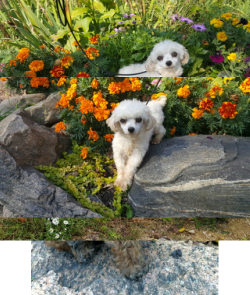About Hypoglycemia:
This condition is normally triggered by stress and occurs in exceptionally small toy puppies between six and twelve weeks of age. Hypoglycemia can occur without warning when a puppy is placed in a new home, becomes exhausted from too much playing, or has digestive upset. Hypoglycemia is a condition in which the blood sugar level drops rapidly. Without immediate attention, the puppy could go into shock and die.
If your puppy is contentedly playing, receiving enough rest/sleep, eating and drinking, and if they're alert, there is no reason for any great concern. If you are in doubt, check with your veterinarian.
Because of the move to a new home is already stressful for the puppy, you should not change the puppy's diet. Any new food change should be added to the diet gradually at a later time. We recommend 1 teaspoon of white Karo Syrup in 1 cup of water for your puppy's water the first week in your new home.
If your puppy is contentedly playing, receiving enough rest/sleep, eating and drinking, and if they're alert, there is no reason for any great concern. If you are in doubt, check with your veterinarian.
Because of the move to a new home is already stressful for the puppy, you should not change the puppy's diet. Any new food change should be added to the diet gradually at a later time. We recommend 1 teaspoon of white Karo Syrup in 1 cup of water for your puppy's water the first week in your new home.
With our toy- sized puppies, we supply canned A/D in our puppy kit. If the puppy is too overwhelmed or excited and stops eating, we recommend mixing in some soft dog canned food, low sodium chicken broth, or spice free canned pumpkin. The additional add ins may help stimulate an appetite in the puppy.
"Small breed puppies, especially Toy breeds, require careful feeding to prevent a condition called hypoglycemia. Hypoglycemia is the scientific word for low blood sugar, and small breed puppies are prone to developing this condition as a result of high metabolic rates and low sugar and body fat reserves. This means they need to be fed a calorie-dense, small breed puppy food anywhere from four-to-six times a day and watched closely for symptoms of hypoglycemia.
Symptoms of hypoglycemia in dogs:
Symptoms of hypoglycemia in dogs:
- Weakness
- Lethargy
- Muscle tremors
- Seizures
Steps to Prevent Hypoglycemia:
"1) Feed small dogs often. Toy breeds and puppies require more glucose than larger dogs, so they are more susceptible to hypoglycemia. To avoid this, feed your small dog often. Feed your dog a meal high in quality protein, high in fat, with complex carbs, like white rice.
3) Feed your dog more before high levels of activity. If your dog is going to be engaging in high levels of activity, such as hunting, then you need to feed him beforehand. Give him food a few hours before the activity. The food should be high in protein and fat.
- Make sure to keep small dogs warm if they are underweight or don’t eat
3) Feed your dog more before high levels of activity. If your dog is going to be engaging in high levels of activity, such as hunting, then you need to feed him beforehand. Give him food a few hours before the activity. The food should be high in protein and fat.
- Intense exercise when a dog hasn’t eaten can cause hypoglycemia.
- Don't strenuously exercise a dog who has just eaten a meal, as this can cause bloating. Wait at least 90 minutes after feeding before exercising your dog."
Sources:
Burke, Anna. “The Best Dog Foods Specially Formulated for Small Breeds.” American Kennel Club, 2 June 2016, www.akc.org/expert-advice/nutrition/general-nutrition/food-for-small-breeds/.
Elliott, Pippa. “How to Prevent Hypoglycemia in Dogs.” WikiHow, WikiHow, 30 Sept. 2017, www.wikihow.com/Prevent-Hypoglycemia-in-Dogs.
Burke, Anna. “The Best Dog Foods Specially Formulated for Small Breeds.” American Kennel Club, 2 June 2016, www.akc.org/expert-advice/nutrition/general-nutrition/food-for-small-breeds/.
Elliott, Pippa. “How to Prevent Hypoglycemia in Dogs.” WikiHow, WikiHow, 30 Sept. 2017, www.wikihow.com/Prevent-Hypoglycemia-in-Dogs.
